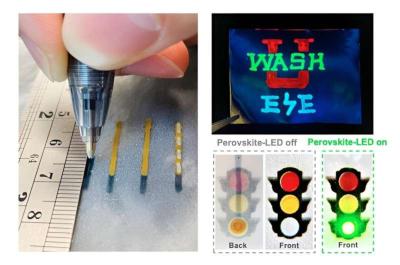Researchers from Washington University in St. Louis and Florida State University have developed a versatile, scalable and eco-friendly handwriting approach to draw multicolor perovskite light-emitting diodes and perovskite photodetectors on various substrates, including paper, textiles, plastics, elastomers, rubber and three-dimensional objects.
The team's method uses common ballpoint pens filled with newly formulated inks of conductive polymers, metal nanowires and multiple perovskites for a wide range of emission colors. Just like writing with multicolored pens, writing layer-by-layer with these functional inks enables perovskite optoelectronic devices to be realized within minutes.
This process is very simple and can be carried out by individuals without specialized training. The handwritten perovskite light-emitting diodes can exhibit a brightness as high as 15,225 cd m−2, a current efficiency of 6.65 cd A−1 and a turn-on voltage of 2.4 V.
The perovskite photodetectors exhibited an on/off ratio of over 10,000 and a responsivity of up to 132 mA W−1.
Though the team had already developed printable ink, translating it for standard ballpoint pens that are feasible for handwriting on everyday materials required a few tweaks to control wettability and improve writability. Most importantly, the scientists had to make sure the ink could be applied to porous and fibrous substrates, including paper and textiles, without running or mixing. Beyond avoiding the aesthetic disappointment of a smudged design, the layers must remain discrete to ensure functional, high-performance optoelectronic devices.
This work offers a route to the integration of perovskite optoelectronics in low-cost and large-area application scenarios such as electronic textiles, electronic paper, smart packaging and other disposable electronics and wearables.




